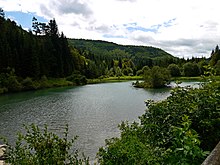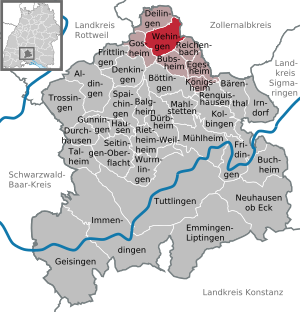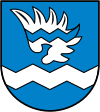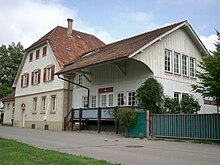Wehingen
| coat of arms | Germany map | |
|---|---|---|

|
Coordinates: 48 ° 9 ' N , 8 ° 48' E |
|
| Basic data | ||
| State : | Baden-Württemberg | |
| Administrative region : | Freiburg | |
| County : | Tuttlingen | |
| Height : | 777 m above sea level NHN | |
| Area : | 14.59 km 2 | |
| Residents: | 3680 (December 31, 2018) | |
| Population density : | 252 inhabitants per km 2 | |
| Postal code : | 78564 | |
| Area code : | 07426 | |
| License plate : | DOES | |
| Community key : | 08 3 27 051 | |
| LOCODE : | DE WGQ | |
| Address of the municipal administration: |
Gosheimer Strasse 14-18 78564 Wehingen |
|
| Website : | ||
| Mayor : | Gerhard Reichegger ( CDU ) | |
| Location of the municipality of Wehingen in the Tuttlingen district | ||
Wehingen is a municipality in the north of the Tuttlingen district in Baden-Württemberg and belongs to the Hohe Schwabenalb natural area on the Swabian Alb . Together with the neighboring town of Gosheim , Wehingen fulfills the function of a sub-center in the northern district of Tuttlingen.
geography
location
Wehingen is located on the Großer Heuberg , a plateau in the High Swabian Alb. In this area the Swabian Alb reaches its highest heights. The location of the place is characterized by the confluence of the western arm of the Bära , the so-called Lower Bära , and the Mühlbach. The middle center of Rottweil is 12 km to the west, the district town of Tuttlingen 18 km south of Wehingen.
Geology and natural classification
The Bära edge heights of the Hohe Schwabenalb are the section in which the Alb reaches its highest heights. The municipality is located in the area of the Mühlbach and the Lower Bära in the Braunjura stage and extends to the Malm plateau of the Alb on the northeastern border of the district . The maximum height of the municipality is 1002 m above sea level. NHN on the northern boundary of the municipality, to the Untere Bära in the extreme southeast, it drops down to 752 m. The entire district is part of the Upper Danube Nature Park .
Neighboring communities
The community borders in the north on Deilingen , in the east on Obernheim in Zollernalbkreis , in the southeast on Reichenbach am Heuberg , in the south on Bubsheim and in the west on Gosheim.
Community structure
The municipality of Wehingen includes the village of Wehingen with the district of Fronhofen , the district of Harras about two kilometers to the east and the Steighaus house. The Wehingen castle ruins are located in the municipality .
history
Wehingen was first mentioned in a document on March 27, 793 in a deed of donation from the St. Gallen monastery. In 843 the village belonged to the Reichenau Monastery and until the 14th century the Reichenau Monastery was also the largest landlord. In 1197 the lords of Wehingen were named for the first time with the knight Hugo von Wehingen . Above the district of Harras, the castle of the Lords of Wehingen was built on the "Schlosshalde", the extensive remains of which are still visible today and indicate a larger castle complex. In 1351 the Lords of Wehingen sold the festival for 600 pounds heller to Duke Albrecht of Austria , who often used the festival as a pledge for his extensive debts. In 1355 the Reichenau monastery sold the village of Wehingen "with its people and goods" to the Alpirsbach monastery. The Lords of Wehingen entered the service of the Austrian dukes. In the following years, the various justice systems in Wehingen led to frequent disputes. Austria claimed and exercised all sovereign rights despite all objections from the Alpirsbach monastery. At that time, the Alpirsbach monastery was the owner of four Kehlhöfe (cellar farms = manor farms) in Wehingen and was the patron saint of the parish of Wehingen, which also included Gosheim. In 1582 Wehingen was finally transferred to the Upper Austrian County of Hohenberg. Austria now had sovereign rulership and retained it until 1805, when Wehingen came to Württemberg .
On October 28, 1828, a fire in Wehingen destroyed 42 houses and with them the apartments of 80 families in just a few hours. The construction aid of the Kingdom of Württemberg essentially owed Wehingen its present-day appearance. The market rights granted in 1830 made Wehingen one of the most important places in the royal superior office of Spaichingen . With the regional reform in 1938, Wehingen came to the Tuttlingen district .
religion
Catholic Church
A pastor in Wehingen was first mentioned in 1245. The church set of the parish church consecrated to St. Ulrich, which is first mentioned in a document in 1299, belonged to the Reichenau monastery and, like the entire town, was sold to the Alpirsbach monastery in 1355 . In 1649, Württemberg exchanged the church rate for the St. Blasien monastery , which ceded it to Austria in 1725. As a result, he returned to Württemberg in 1805. After a fire, the church was rebuilt and consecrated to St. Ulrich on October 3, 1738 . The nave was replaced by a neo-Romanesque nave in 1898/99 and consecrated again on September 19, 1899.
The first parish church in Wehingen , the Fronhofer Church in Fronhofen , was first mentioned in a document in 843. The Fronhof church in its current form dates from Romanesque and late Gothic times and received a tower with a stepped gable in the 15th century.
Protestant church
In addition to Wehingen, the parishes of Reichenbach, Gosheim, Deilingen and Egesheim also belong to the Protestant parish of Wehingen. For the entire area of the parish there is a Protestant church, the Christ Church, built in 1962. Before the Second World War there were only a few Protestant Christians on the Heuberg. This situation changed after 1945, when many refugees and displaced persons came from the formerly German eastern regions, so that the Protestant population increased. Due to the influx of Russian-German repatriates, mainly from Kyrgyzstan and Kazakhstan , the Protestant parish has grown again.
New Apostolic Church
The congregation of the New Apostolic Church in Wehingen belongs to the church district of Villingen-Schwenningen .
Islam
Since 1983 there has been a Turkish-Islamic cultural association in Wehingen that maintains a mosque in Wehingen.
politics
Administrative association
The community is the seat of the community administration association Heuberg , in which the communities Bubsheim , Deilingen , Egesheim , Gosheim , Königsheim , Reichenbach and Wehingen have come together.
Municipal council
After the local elections on May 25, 2014, the municipal council has 14 members in addition to the mayor as chairman.
| CDU | : 51.1%, 7 seats |
| Free voters | : 48.9%, 7 seats |
| voter turnout | : 45.2% |
mayor
Mayor Josef Bär was also honorary mayor of Egesheim and Reichenbach am Heuberg.
Gerhard Reichegger has been mayor of the community since 2016.
Partnerships
Wehingen has had a partnership with the French community of Saint-Berthevin in the Mayenne department , around four kilometers from the town of Laval , since 1969 . In summer 2009, the 40th anniversary of the partnership was celebrated in both communities.
Coat of arms and banner
| Blazon : "In blue over a lowered silver (white) zigzag bar, a silver (white) wing covered with a blue zigzag bar." | |
| Justification of the coat of arms: The coat of arms, first awarded in 1930, is derived from the coat of arms of the Lords of Wehlingen. In order to avoid confusion with the coat of arms of the former municipality of Tieringen , the wing was added in 1961. |
"The banner is striped white and blue lengthways with the coat of arms above the middle."
Culture and sights

The municipality is affiliated with the "Donaubergland" tourist association.
Buildings
- The Catholic parish church of St. Ulrich was first mentioned in a document in 1299. Their organ was made by the Braun brothers from Spaichingen (1843).
- The Evangelical Christ Church was built in 1962.
freetime and sports
Wehingen has a well-developed network of cycling, walking and hiking trails as well as cross-country trails that are groomed in winter and run across the entire Heuberg and connect the communities of Böttingen and Bubsheim . There is also a ski slope on which ski courses are offered in winter. There is also a football pitch and a hockey pitch, which can also be used as a basketball court.
Infrastructure and economy
As a result of the fire on October 28, 1828, in which large parts of the village were destroyed, Wehingen received construction aid from the Kingdom of Württemberg in the form of privileges, such as the market rights granted in 1830 and the settlement of state institutions. Since then, various offices have been established in Wehingen by royal order.
Authorities and agencies
In Wehingen there is a police post of the state police and the rescue station of the German Red Cross for the northern district. An actuary and a notary's office for the Heuberg area is based in Wehingen, but will be closed until 2018 due to the notary reform of the state of Baden-Württemberg. Until the Administrative Structure Reform Act (VRG) came into force in 2005, Wehingen was the seat of a state forestry office , which existed as a branch of the Tuttlingen district forestry office until 2015 and was then relocated to Tuttlingen.
Local government association Heuberg
Wehingen is the seat of the Heuberg municipal administration association . It was created in the course of the district and community reform of Baden-Württemberg in 1972 when the communities of Bubsheim, Deilingen, Egesheim , Gosheim, Königsheim , Reichenbach am Heuberg and Wehingen merged. The association's territory extends over an area of 6,125 hectares . The municipal administration association performs tasks for its member municipalities, e.g. B. the land-use planning , the accounting and cash management , the tax assessments, the tasks of the lower building law authority and the lower monument protection authority as well as tasks of the local road traffic authority . The association also operates the wastewater treatment plant in Egesheim.
economy
Wehingen is an industrial community with almost 1,800 jobs. The commuter balance is positive, more than 1,100 workers come from outside the community, while around 700 Wehingers earn their living outside the community. Metal and plastic processing companies, machine and apparatus construction, manufacturers of plastic injection and deep-drawing parts as well as electronic and electrotechnical companies dominate. The trade, specialist retailers and the catering trade are also represented by numerous efficient companies.
traffic
Wehingen is on the state roads 433 and 435, which connect to the federal highways B 14 and B 27 , respectively . While Wehingen was connected to the railway network by the Heubergbahn from Spaichingen to Reichenbach (Heuberg) until 1966 and had two train stations (Wehingen and Harras-Obernheim), the place can now be reached by bus, which has a connection to the ring train in Aldingen .
education
- Realschule Gosheim-Wehingen with over 574 students in 20 classes
- Gymnasium Gosheim-Wehingen with 444 students in 13 classes
- Schlossbergschule (elementary and technical secondary school)
- Mutpol - School of Life (Diaconal youth welfare)
Personalities
- Leo Linse (1850–1910), Benedictine monk in Beuron, Abbot of Fort Augustus / Scotland (1888–1909)
- Johann Bauser (1827–1899), mayor and savings bank treasurer in Titisee-Neustadt
- Hans Dieter Ochs (* 1936), immunologist, pediatrician and university professor
- Simone Hauswald (* 1979), biathlete
Individual evidence
- ↑ State Statistical Office Baden-Württemberg - Population by nationality and gender on December 31, 2018 (CSV file) ( help on this ).
- ^ The state of Baden-Württemberg. Official description by district and municipality. Volume VI: Freiburg District Kohlhammer, Stuttgart 1982, ISBN 3-17-007174-2 , pp. 636–637.
- ^ Yearbook of the Association for the History of the Augsburg Diocese, 1973
- ↑ LEO BW - discover regional studies online LEO BW website - discover regional studies online. Retrieved January 10, 2016.
- ↑ moscheesuche.de
- ↑ [1]
- ^ Flag of the municipality of Wehingen
- ^ [2] Reform of the Baden-Württemberg notarial system
- ↑ [3] Law on the reform of the administrative structure, the reform of the judiciary and the expansion of the municipal scope for action (Administrative Structure Reform Act - VRG) of July 1, 2004







